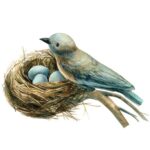
Log in the wood-stove at the end of the day and settling into the hockey game with a beverage. Then a cluster fly lands on your head and starts buzzing in your hair. Really? You flick it on the floor and it spins itself to death. Time to grab the Dyson and vacuum it up, along with the caravan of ladybugs that have expired on the windowsill.
Ladybugs, cluster flies, it makes you wonder: how come the icy blasts of winter didn’t destroy them with the first killing frost? It boils down to this: Mother Nature has taught them well.
The cluster flies in your house arrived in the fall when the walls were warmed by the sun. Along with box elder beetles, spiders and stink bugs, they crept into every crack, crevice and hole they could find to make their winter home. There, they huddled into pods of several hundred – under siding, in insulation or any confined dark pocket away from the cold wind – and went dormant. They changed their body chemistry (scientific name: diapause) by increasing lipids, proteins, and forming glycol (antifreeze). In the depth of winter, the insects that stay snuggled together in the huddle pod will survive, while some of those on the periphery will perish. (The one that landed in your hair was pretty much doomed.) Individual cluster flies outside their pods are attracted to light and warmth – usually a lamp in the evening where they can bounce about inside the shade with a remarkable talent to annoy us. Without the sanctuary of the pod, the errant flies and ladybugs will eventually die.
These bugs can withstand several freeze/thaw cycles during the winter and will emerge when warmer spring temperatures stabilize. A prolonged mild spell may not bode well for both cluster flies and ladybugs as it may trigger an early emergence from their winter homes. They can’t survive outside in temperatures below the freezing mark.
Insects that don’t check in to winter housing accommodation still find a way of making it through the cold months, and it doesn’t involve heading for Florida. Mosquitoes have a three-pronged approach to winter survival. In autumn, females lay eggs in the soft, wet earth around ponds and in swamps. They lie dormant all winter, protected from freezing by a covering of moisture from fall rains and a carpet of leaves. In spring, when temperatures rise and sufficient warm rains have fallen, mosquito eggs hatch into larvae and complete their cycle to adulthood. Larvae and pupae that are in water in the fall go into a deep sleep, and when spring arrives, they wake up and carry on life in a new year.
Having laid their last brood of eggs in the fall, the female mosquitoes are not satisfied with just dying off so we can enjoy a decent day once spring comes – nope, no way! These little bloodsucking critters head for animal burrows, hollow logs and tree bark for a winter’s nap. Like the cluster flies, they withstand freezing and thawing by changing their body chemistry to survive the frigid temperatures. The same warm weather that draws you to your first deck visit, also beckons the female mosquito, as she needs to consume someone’s blood to lay her first brood of eggs – and it might as well be yours.
The largest pests we endure, the deer flies and the horse flies, overwinter as maggots below the frost line, feeding on decaying organic matter and small insects. The first hatch emerges in early June. And the flies that hatch are out for blood, aggressively slicing through animal and human skin with four-sided razor-sharp mandibles to access their food source. They land, and similar to a small tree spade, with one chomp take out a plug of skin and slurp up the free-flowing blood. Once the females have a belly full of blood, they lay their eggs in moist soil near swamps, marshes and watercourses.
Blackflies are a little different. Their eggs survive in the running waters of creeks and streams. When water temperatures increase to between 4C and 10C, they hatch into larvae (usually following a warm rain). The adults rise up from the bottom on an air bubble. The same warm May rains that stimulate the hatch of the blackfly usually cause the emergence of morels, providing the blackflies with a smorgasbord of human morel seekers in the bush. Our local insects have unique survival characteristics. Despite being cold-blooded, these simple insects have hung on for over 30 million years – not much chance we will be bug-free anytime soon.
Story by:
Roger Thomas




